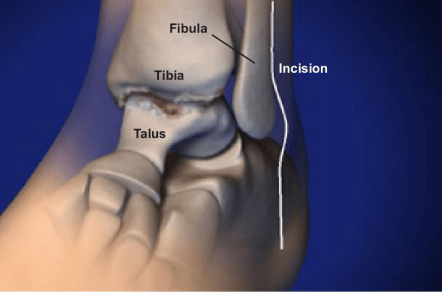Ankle Fusion Surgery
An ankle fusion surgery is used to help treat severe arthritis or injury to the ankle joint. During the procedure, the surgeon identifies and removes damaged cartilage and bone which then allows them to fuse the joint. This fusion stabilizes the ankle and relieves pain.
Symptoms
The Omaha Foot & Ankle Specialists at MD West ONE are able to properly diagnose the condition, severe arthritis, which may lead to an ankle fusion surgery. If you have the following symptoms, you may want to make an appointment with one of our Board Certified Specialists.
- Severe pain, stiffness, and inflammation
- These can lead to difficulty walking
Types of Arthritis
Severe arthritis is a common reason for ankle fusion surgery to be recommended for treatment. Types of arthritis that may lead to the symptoms above include:
- Osteoarthritis - Develops from wear and tear on your joints over time
- Post-traumatic arthritis - Occurs after a significant ankle injury such as a fracture
- Rheumatoid arthritis - An autoimmune disease that damages your joints
Before recommending surgery, though, your healthcare provider will try to treat your ankle arthritis with non-surgical options like:
- Activity modification like avoiding prolonged standing and walking
- Anti-inflammatory medications or topical treatments
- Corticosteroids injections
- Supportive devices including braces, a walker, a cane, etc.
- Physical therapy and exercise

Surgical Procedure
If surgery is recommended to treat your symptoms, it will join your ankle bones using screws or plates to eliminate the pain. In preparation for the procedure, you are given anesthesia and once it is administered and your surgeon is ready, they will make an incision along the outer side of the ankle in order to expose the joint. The procedure then generally happens in three parts:
Modifying the Fibula
The fibula is the long bone that rests against the tibia. The surgeon removes the end of the fibula to modify it in this first part of the procedure. In some cases, a second incision may need to be made because the surgeon determined the bony bump that protrudes from the inner side of the ankle needs to be removed as well.
Reshaping the Joint
The second step of the procedure includes the identification of damaged cartilage and bone from the end of the talus and the tibia which is then removed. The surgeon then reshapes these bones and aligns them properly. In some cases, bone grafts are required in the gaps of the ankle in order to achieve optimal alignment. If so, they are often taken from the removed section of the fibula but can also achieve the same results by taking them from the bone of the heel or the pelvis.
Stabilizing the Ankle
In the last step of the surgery, the surgeon stabilizes the ankle using a series of plates or screws in the properly aligned bones. The tibia and talus are now joined by the hardware but over the next several weeks, these bones will fuse together permanently. The surgeon will close the incision after stabilizing the ankle with hardware which concludes the procedure.
Possible Complications and Risks of an Ankle Fusion Surgery
All surgeries come with risks. For ankle fusion surgery, nonunion is the biggest risk. This is when the ankle bones fail to fuse and happens in about 10% of cases. An ankle fusion can also increase the rate of arthritis in your foot and nearby joints as these joints in your foot will now take on more stress.
There are many considerations to take into account before an ankle fusion procedure. For example, your surgeon might not recommend the procedure after the imaging tests show the following issues:
- Not enough or poor quality of bone
- Bad nerve function
- Severe deformity of your leg
Some complications are possible no matter what type of surgery you’re having. They include:
- Problems with anesthesia
- Blood clots
- Bleeding
- Infection
- Damage to nerves
Post Operative Care for an Ankle Fusion
Typically, your foot and ankle will be placed in a cast immediately after surgery and crutches will likely be needed for six to eight weeks. The most pain you will experience will be in the first two weeks after the surgery as your incision heals.
As the bones fuse together, you will be able to gradually bear weight on the leg and ankle. It will be about six to 12 weeks before you can completely put weight on the ankle, though. When you’re allowed to walk you’ll have to wear a boot or cast that protects your ankle. In most cases, physical therapy will start four to six weeks after the operation and many patients can resume their normal activity within three to six months. Since the tibia and the talus are now permanently joined, the ankle will no longer flex and extend, but it will retain a side-to-side range of motion.
Once your bones successfully fuse and heal, you should be able to return to many activities, including:
- Walking
- Hiking
- Cycling
Keep in mind that you will no longer be able to run or jump on a fused ankle. Talk to your healthcare provider about how soon you can go back to work or school. You might still be using crutches or a wheelchair when you return.
When should you contact your healthcare provider or go to an emergency room?
Your healthcare provider will schedule follow-up visits after your procedure but if you are experiencing any of the following symptoms, it's important to schedule an appointment right away or go to the emergency room.
When to see your healthcare provider:
- Warmth or redness around the incisions
- Slow healing
- Oozing pus from the incisions
When to go to the emergency room:
- A high fever
- A sudden loss of sensation in the foot
- Excessive pain not able to be controlled by elevation and medication
- Onset of shortness of breath or chest pain
Meet MD West ONE's foot and ankle specialists and learn more about how they treat Achilles tendon injury.
AMERICAN ORTHOPAEDIC FOOT & ANKLE SOCIETY
All of the foot and ankle surgeons in the practice are recognized members of the American Orthopaedic Foot & Ankle Society. It is the oldest and most prestigious medical society dedicated to the foot and ankle. The mission of the society is to advance science and practice of foot and ankle surgery through education, research, and advocacy on behalf of patients and practitioners. These physicians dedicate their time and energy to improving the patient experience and their knowledge in their field. For more information visit http://www.aofas.org.
MD West ONE Foot & Ankle Specialists:
The Foot & Ankle Specialists are all Board Certified and Fellowship-Trained, meaning they’ve focused their education, training and research on orthopaedic surgery of the foot and ankle.





